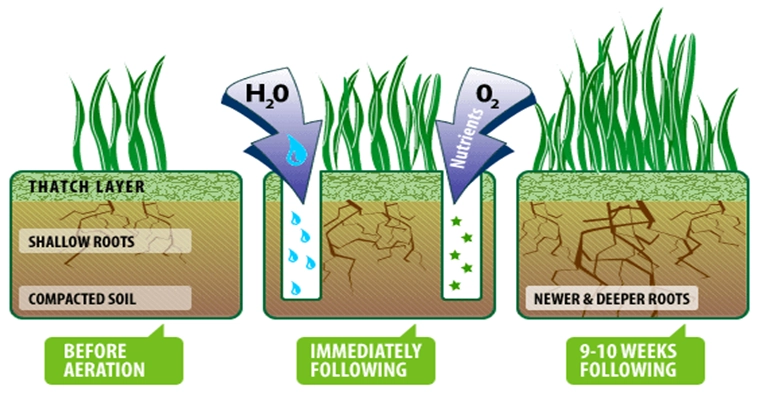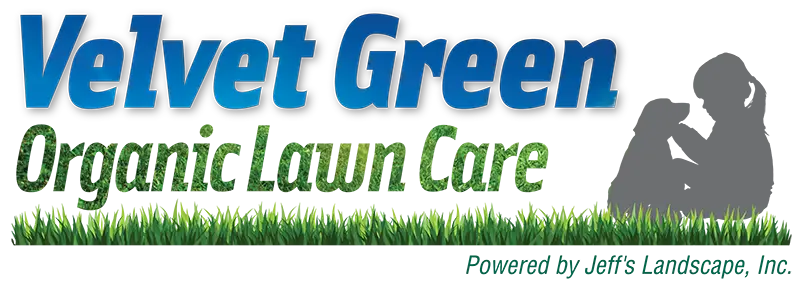Aeration, Overseeding & Topdressing
The Secret to Beautiful Turf
Why all three services?
Good: Aeration alone
Over time, the soil in lawns becomes compacted. This can be caused from a variety of factors, including regular wear and tear from kids and pets and any heavy construction equipment used for remodeling projects. Grass roots need air to breathe and space to grow. Compacted soil strangles and suffocates grass roots and makes it difficult for new grass to take root. Aeration will loosen up the compacted soil and free up space for grass to grow.
Better: Aeration and overseeding
Aerating is a great way to improve the health of your lawn, but overseeding is a natural addition to the process. The combination creates good seed-to-soil contact. Rather than just throwing seed on top of the lawn, aerating before seeding will allow the seed to fall into the holes for a better germination rate. Aerating before seeding also gives young grass seed space to grow.
Best: Aeration, overseeding, and topdressing
Aeration and overseeding make a great pair but adding compost topdressing takes it to the next level. Adding this step to the process protects the young grass seed by covering it with a layer of compost loaded with beneficial organic material. This also closes the holes created by the aerating step which provides even more seed-to-soil contact. This three-step process, coupled with proper watering techniques, is the best way to ensure maximum germination of grass seed.
Aeration, overseeding, and topdressing in the second half of the lawn care season are key to improving the growing environment for your lawn. At Velvet Green, we always complete these three services in order described. Technically, this means we are “under-seeding” your lawn as we add the compost on top, but that means the seed is exactly where it needs to be to grow-- in the soil, not on the soil.
Benefits to Core Aeration, Overseeding, and Compost Topdressing:
- Fills in bare spots to provide a thick, green lawn
- Chokes out weeds and crabgrass
- Loosens and decompacts your soil
- Increases root development
- Increases water retention
- Improves overall plant health
There is no arguing the fact that a thick healthy lawn is the absolute best defense against weeds and crabgrass. If you have thin or bare areas in your lawn, aeration, overseeding, and compost topdressing is an absolute must.

Why Organic? Why Does It Matter For My Lawn?
Organic lawn care works with nature to provide you with a healthy lawn. By utilizing organic fertilizers and bio-stimulants, organic lawn care reduces the impact on the environment and provides your family with a safe place to enjoy the outdoors. By going organic you are reducing the use of chemical fertilizers, herbicides, fungicides, and insecticides. How is this possible? Having an organic lawn starts in the soil, if the soil ecosystem is healthy and the conditions are right a healthy lawn will follow. A healthy lawn has a deep root system, tall leaves, and dense growth. If you want an outdoor space that is friendly to the environment and your family organic is the way to go.
The keys to organic lawn care:
- Bio-stimulants – Bio-stimulants are active, beneficial microorganisms that unlock plant nutrients in the soil. There are many naturally occurring nutrients in the soil that your grass can’t take in because it is in the wrong form. The microorganisms in bio-stimulants will break down those nutrients as well as those applied in organic fertilizers and release them to your lawn for uptake. Bio-stimulants are the key to a successful organic lawn care program and can significantly reduce the amount of supplemental nutrients needed for a healthy lawn.
- Organic fertilizers – By using fertilizers derived from natural, sustainable sources we are drastically reducing our impact on the environment before the product is even applied to your lawn. Once the organic fertilizer is introduced to your lawn it is absorbed into the soil and through the leaves of the turfgrass. The organic fertilizer is then broken down by the bio-stimulants.
- Seeding – A thick turf canopy is crucial to preventing weeds organically. It also makes for a beautiful lawn. By seeding lawns on a regular basis we are building a thick turf canopy and introducing new seed varieties of grass that are tolerant to drought and other stresses.
- Cultural practices – Following proper cultural practices will help to build a dense turf canopy and improve the overall health of your lawn. Cultural practices like proper mowing heights, sharp mower blades, regular watering, and leaving lawn clippings will all improve your lawns health.
- Watering – Like any living thing water is crucial to keep grass alive and healthy. Without adequate water your lawn will go dormant pulling all its energy out of the leaves and into the roots. Deep infrequent watering will help to build a strong, deep root system that will store energy in times of stress. Lawns typically require at least one inch of water per week. Applying a quarter inch of water every other day or a half inch of water every third day is a good practice to follow for a healthy lawn. Be sure to work with mother-nature and only apply water through an irrigation system if there has been no significant rainfall.
- Soil Testing – A healthy lawn starts from the soil up and soil testing is the base for a successful lawn care program. We perform a laboratory soil analysis for every lawn we care for. The soil test provides information on soil pH, cation exchange capacity, macronutrients, micronutrients, and organic matter. Keeping these factors in balance is vital to a healthy lawn. By performing a soil test we can identify areas where your soil is deficient and take steps to remedy those problems.
